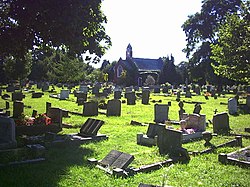| North Sheen | |
|---|---|
Location within Greater London | |
| OS grid reference | TQ195765 |
| London borough | |
| Ceremonial county | Greater London |
| Region | |
| Country | England |
| Sovereign state | United Kingdom |
| Post town | RICHMOND |
| Postcode district | TW9, TW10 |
| Dialling code | 020 |
| Police | Metropolitan |
| Fire | London |
| Ambulance | London |
| UK Parliament | |
| London Assembly | |
North Sheen is an area of London, England in the former Municipal Borough of Richmond (Surrey). [1] [nb 1] It was incorporated into Kew in 1965 when the London Borough of Richmond upon Thames was created. [2]
Contents
There is a North Sheen Bowling Club, [3] North Sheen Cemetery [nb 2] and North Sheen Recreation Ground. [4]




